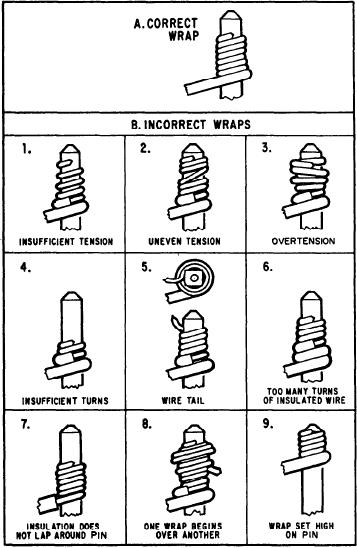
hole at the end of the barrel (fig. 10-1, view A).
The groove (or hole) for the wire is carefully sized
to provide the exact amount of tension needed to
form a secure wrap. Ensure the insulation bottoms
into the wire funnel as shown in view B of figure
10-1. This will allow you to wrap the correct
amount (one to one and a half turns) of insulated
wire around the wrap pin. Anchor the wire by
bending it into the notch in the sleeve (fig. 10-1,
view C). The center hole at the end of the barrel
is next slipped down over the pin (fig. 10-1, view
D). When the barrel is rotated about the pin, the
wire will twist around the pin (fig. 10-1, view E).
As the wire twists around the pin, the stripped
portion of the wire that is being held in the groove
(or in the other base hole) will be drawn down
to twist and coil around the pin. The barrel of
the wire-wrap tool rotates as a result of finger,
hand, or motor action. The action depends upon
the tool's design. The coiling action of the wire
on the pin lifts the tool enough to continue the
wire coil up the pin, as shown in views F and G
of figure 10-1. However, too much pressure on
the tool will cause the coils to "bunch," or
overlap. If you are replacing a wire, carefully run
the wire to the next connection and perform the
same procedure on the opposite end. Be sure you
allow enough excess wire for the wraps needed
on the pin.
Before actually doing a wire wrap on the
item you are repairing, take time to practice
this procedure. Find a spare connector or
Figure 10-2.--Correct and incorrect wire wraps.
spare pin similar to those you are repairing.
Using the same materials that are required
2. Overtension on wire--results in loose
for the actual job, practice a few times.
connection (detected by turn overlaps
Figure 10-2, view A, shows a good wire wrap.
and insufficient surface contact with the
It has five to seven and a half snug turns
of wire. Place the insulation about the bottom-
pin)
m o s t one or two turns with no spacing
3. Insufficient number of turns (less than
between adjacent turns, no bunching as one turn
five)--poor contact (insufficient wire was
attempts to cover another, and no observable
stripped first)
nicks in the wire. The number of turns is
determined by the wire gauge. Larger diameter
4. Insulation does not extend to pin--
wires and pins require fewer turns, and smaller
increased chances of shorts or wire breaks
diameters mean more turns.
(too much wire was stripped)
The following list describes a variety of IN-
5. Reuse of an uncoiled wrap--each re-
CORRECT methods of wire wrapping. Some of
use increases the likelihood of wire
these are visually identifiable in figure 10-2,
breaks
view B.
6. Attempts to wrap by hand--insufficient
1. Insufficient tension on wire--results in
and uneven tension results in poor con-
loose connection (detected by open spaces
tact
between adjacent turns)
10-3

